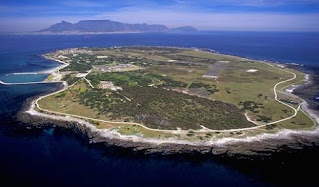Robben Island
Certainly, here is more detailed information about Robben Island, including its history, general information, attractions, and interesting facts:
General Information :
Location : Robben Island is situated in Table Bay, approximately 6.9 kilometers (4.3 miles) off the coast of Cape Town, South Africa.
Size : The island covers an area of about 5.07 square kilometers (1.96 square miles).
Designation : Robben Island was designated as a UNESCO World Heritage Site in 1999.
History:
Early History: Robben Island has a long history that predates its use as a prison. It was initially used as a place of banishment and isolation. In the 17th century, the Dutch colonial authorities used it as a penal colony, a leper colony, and a place to isolate political dissidents.
Apartheid Era: Robben Island became internationally known for its role during the apartheid era. It was used by the South African government to incarcerate political prisoners, particularly those involved in the anti-apartheid struggle.
Nelson Mandela: The island is famously associated with Nelson Mandela, who spent 18 of his 27 years in prison on Robben Island. His imprisonment and eventual release became powerful symbols of the struggle against apartheid.
Attractions:
Prison Tours : Robben Island is primarily known for its guided prison tours, which offer visitors the opportunity to explore the maximum-security prison. You can see the cramped cells, communal areas, and learn about the experiences of political prisoners.
Nelson Mandela's Cell: A significant attraction is the cell where Nelson Mandela was held. It is a small, Spartan room that provides insight into the conditions Mandela and other inmates endured.
Museum and Exhibitions: Robben Island has a museum that offers historical context about the apartheid era, the struggle for freedom, and the significance of reconciliation in South Africa's history. The museum features exhibitions with photographs, artifacts, and stories of former inmates.
Wildlife and Natural Scenery: Beyond its historical significance, the island is home to a colony of African penguins. Visitors can also appreciate the island's natural beauty, including its rocky shores and unique flora and fauna.
Facts :
- The name "Robben" is Dutch for "seal," which references the seals that once inhabited the island's shores.
- Robben Island was used as both a prison and a military base during different periods of its history.
- The release of the last political prisoners from Robben Island in 1991 marked a critical moment in South Africa's transition to democracy.
- Four years after his release from Robben Island, Nelson Mandela was elected as South Africa's first black president in the country's first fully representative democratic election in 1994.
- Robben Island is considered a symbol of the struggle against apartheid and serves as a museum and heritage site that embodies the principles of forgiveness, reconciliation, and justice in the post-apartheid era.
Robben Island remains a powerful and symbolic location, representing both the oppression of apartheid and the triumph of the anti-apartheid movement in South Africa. It is an essential historical and cultural site, attracting visitors from around the world who seek to understand this important chapter in South African history.
Certainly, here's some additional information about Robben Island :
Notable Inmates :
In addition to Nelson Mandela, other prominent anti-apartheid activists and political prisoners were held on Robben Island. These include Walter Sisulu, Govan Mbeki, Ahmed Kathrada, and many others. The prison was a place where these individuals continued their resistance and political organizing even while incarcerated.
Prison Conditions:
Life in the Robben Island prison was incredibly harsh. Political prisoners endured forced labor, meager rations, and tough physical conditions. They were often subjected to inhumane treatment and forced into hard labor, such as breaking stones or working in the island's lime quarry.
End of Apartheid:
Robben Island played a significant role in the dismantling of apartheid. After the release of Nelson Mandela and other political prisoners in the early 1990s, the island transitioned from a place of confinement to a symbol of freedom and reconciliation. It became a powerful backdrop to the negotiations that led to the end of apartheid.
Robben Island Today:
Robben Island is now a popular tourist destination, attracting visitors from around the world who want to learn about South Africa's history and pay their respects to those who struggled for justice and equality. Tours are conducted by former political prisoners, providing a unique and personal perspective on the island's history.
Robben Island Today:
The African penguin colony on Robben Island has become an important conservation site. The colony was established in the 1980s, and efforts are made to protect these endangered birds and their habitat.
Challenges of Erosion:
Robben Island faces challenges from erosion due to rising sea levels and climate change. Preservation efforts are ongoing to protect the historical structures on the island.
Robben Island is a place of historical significance and a symbol of the triumph of human spirit over oppression. It remains a vital reminder of South Africa's journey from apartheid to democracy and reconciliation. Visiting the island offers a unique opportunity to learn about this history and honor the resilience of those who fought for justice and equality.






0 Comments